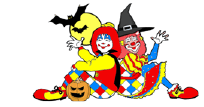Generally speaking, brushes which are of higher quality will enable you to do a better job when face painting than poor quality brushes. This applies to paints as well, but you have only to ask painters who have arrived at events for which materials have been provided to hear the stories about having had to attempt face painting with bad brushes. A good brush makes a huge difference. It’s also important to understand which brushes work best for each job so you can be efficient while painting, although as Marcela Murad of FABAIC has said, you should practice until you can make any stroke with any brush.
The most commonly used brushes for face painters have synthetic bristles, since animals hairs such as sable, while performing well, also tend to also be more expensive. The best brushes should keep a good point (for the rounds), have a nice spring so they return to their original shape, and be durable over time.
Brushes will have either acrylic or wooden handles, and there are good brushes in either category. The disadvantage of wooden handles, although some of my favorite brushes are of that type, is that it is possible for them to swell in water, which can crack the finish on the handle, making them more vulnerable. To avoid this, I lay my brushes flat while using them rather than standing them up on end and do not allow them to stand in water. Despite these precautions, a few of my brushes have experienced a little cracking in the handle. I’ve fixed them by allowing them to dry out completely and applying a couple of coats of polyurethane above the ferule.
Basic brush types
If you’re unfamiliar with the different types of brushes, I hope the descriptions below will help you find the ones you need most for face painting.
• Round brush and pointed round brush—The round brush excels when making tear drops, swirls, and flower petals. It’s a quick choice for filling in small areas, and the smaller sizes are great for details. You should have several sizes ranging from #1 for the smallest to #6. If you like bold teardrops and designs, try out the #8, #10, or the #12.
• Liner, rigger, or script brush—The liner, which is also known as a rigger or script brush, is a round brush with long, slender bristles. My most used liner is a #2 or #3, and it’s wonderful for outlining masks, because it holds more paint than it’s shorter counterparts so I don’t have to reload my brush as often. Liners work especially well with the wax-based paints, which flow nicely from them, and I keep two or three in my kit for use with white, black, and other colors.
• Flat and bright brushes—Flat and bright brushes are very similar, as both have squared off tips, except that brights have shorter bristles. For my larger flat brushes, I use brights, for which the length of the brush is equal to the width. For my smaller flat brushes (1/2-inch and less), I use flats, which have longer bristles. If you’re a fan of one-stroke designs, you’ll want to keep at least four or five of the 1-inch or 3/4-inch flat brushes in your kit, and a few of the smaller sizes as well.
• Filbert (or double filbert)—Filberts are like flats except that they have a curved end. They are particularly useful for any design with rounded shapes, and like a flat brush, are great for covering large areas quickly. The end of a double filbert has a tip which has been divided into two curved shapes, making it a good choice for flower petals.
• Angle brush—The angle brush is another favorite of some painters, and is commonly used for making one-stroke roses, flower leaves, and edges for butterflies. An angle brush is like a flat with the end cut at an angle.
• Dagger brush—The dagger brush is an exaggerated version of the angle brush, its sharp point making it useful for creating whiskers.
• Fan brush—The fan brush is aptly named for it’s fan shape, and although it may not be used frequently, is useful for creating light, wispy strokes, and excels for making the look of fur.
• Chisel brush—In the world of face painting, chisel brush refers to a brush which is short like a bright and rounded like a filbert. The larger sizes are great for covering large areas and doing one-stroke designs. The smaller sizes are useful for blending and creating shadows.
• Wisp brush—The wisp brush comes in the form of flats, filberts, and other types of basic brush shapes, except that the bristles have been cut short at regular intervals, resulting in a raking appearance to the stroke. The wisp brush is useful for creating several parallel lines simultaneously in a stroke.
As a face painter, your most used brushes will probably be the flats, rounds, filberts, and angle brushes, and you should have a few of each kind in your kit, but I’d also suggest trying out the other brush types. Depending on your own painting style, one of them may become a favorite for you as well.
Beth MacKinney is the owner of and primary face painter for Face Paint Pizzazz in the NW Chicago suburbs. She also writes for Examiner.com as the Chicago Face Painting Examiner.







